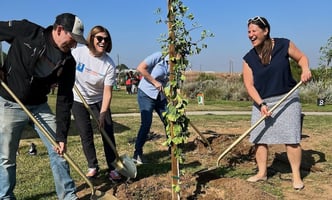We use volunteers as friendly support agents for our nonprofits, so why do we need to worry about a...
Best Practices for Engaging Employee Volunteers
An employee volunteer program is any formally organized effort by a company to motivate its staff to volunteer. Employee volunteers serve as brand ambassadors, helping to make corporate social responsibility goals and improve the company image among stakeholder audiences.
Corporate volunteering also helps make staff more content, improve workplace outcomes, and raise staff retention. In fact, a Deloitte study (2017) found that 70% of working Americans think volunteer activities are better at boosting employee morale than happy hours.
However, these outcomes only are a result if an employee volunteer program follows a basic set of best practices. One of those best practices, in today’s post-COVID reality, is that employee volunteer programs utilize the best tech tools available in designing and implementing a program to help streamline coordination across a diverse workplace reality (virtual, multi-location, and multi-time zone) and to improve efficiency in administration, impact measurement, and employee volunteers’ satisfaction.
The Top Reasons Every Company Needs an Employee Volunteer Program
Younger people under 40 now make up most of the workforce. They almost demand that they have a workplace platform to be employee volunteers. They also can demand it in our post-COVID world where top talent is more stretched than ever. In a 2014 survey, 55% of Millennial workers said they were persuaded to take a job after learning of CSR initiatives in the recruitment process, including opportunities for volunteering. They want to see that companies make a strong impact with internal and external stakeholder audiences, and employees can be a part of that impact.

.At the same time, companies reap benefits from having an employee volunteer program.
- Keeping employees in a difficult talent market. It improves human resource retention by a significant margin, as employee volunteers feel more connected to their companies and take pride in their role in helping others outside the company.
- Improving your CSR improves your brand. Nearly all consumers now say they will choose a product or service from a socially minded company over one that is not socially minded. More volunteering impact equals more audience impact that you can demonstrate to your target markets.
- Improving employee skill sets. Employee volunteers can learn specific skills, especially “soft” skills, from participating in volunteer activities. Deloitte (2016) found that 92% of American workers think volunteering improves their business skill set.
- Creating a happier workforce. At least 30% of Americans have a diagnosed mental health condition, most frequently anxiety and depression (of course, many more may have an undiagnosed condition and many more may have days when they don’t feel like themselves). Many times the workplace is a driver of intensifying conditions. Volunteering is proven to help lower blood pressure and relieve anxiety by releasing endorphins. A happier workplace can be contagious and spread to others, improving productivity and overall job satisfaction.
Now that you know why your enterprise needs a great employee volunteer program, get started with a volunteer management tool designed for that!
9 Steps to Create a Program that Works for Your Company
As you can be inspired by the many benefits volunteering promotes, it is beneficial for any company to have some sort of employee volunteer program. The question is, how do you go about evaluating the best type of program for your specific company?
-
Step 1: Assessment. You must look at your company’s size, resources, and capacity to support employee volunteers and your own CSR goals. Any program needs to have a management structure and a support structure. How are you going to identify opportunities, track hours, and reward employee volunteers? Do you want to support one-off events for teams or have self-directed volunteering? Also, do you have opportunities for volunteering already set up that you can connect with (such as from direct organizers of programs or aggregators of other organizations’ programs)? A good tool is a SWOT assessment to understand your strengths, weaknesses, opportunities, and threats in regard to interacting with those outside the company and meeting your own CSR goals within the context of your available resources.
- Step 2: Coordinate CSR and Human Resource Goals. Along with matching volunteers to opportunities that fit with your CSR goals, you have to consider what the goals of your staff are for participating as employee volunteers. Do they want an opportunity for self-directed volunteering or do they want to volunteer in teams to work more closely with their co-workers? What are your employees’ hopes and goals for volunteering? How will meeting these goals improve their relationship with your company and your company’s relationship with the outside world?
- Step 3: Secure Support from Top Executives. Ask your executives and team leaders what skill sets are missing in their workforces and try to tailor volunteer opportunities toward filling those gaps through learned experience while serving. Skills-based opportunities (such as mentoring) usually result in stronger skills development, helping staff sharpen their capacity in given fields.
What type of budget do they need to be able to support a volunteer initiative? Some models, like employee time off, would require that staff take actual time away from their jobs to volunteer. This can be detrimental by reducing work outputs in your different corporate sectors, so you want to make sure awareness of downside risk is part of the design process.
- Step 4: Seek Out Partnership Opportunities from Your Team. You may already have some local charities or opportunities in mind to pair with your new employee volunteering program, and your employees may already be supporting some on their own that they’d like to more closely associate with their relationship with your company. If you don’t have existing relationships, or if you want to broaden your awareness, you might consider taking advantage of a state-of-the-art platform like Golden that helps you curate appropriate volunteer opportunities and supports your volunteer management processes. If you do have these relationships, you can bring your partners onboard to share live volunteering reporting in Golden for free. Different charities offer different types of opportunities, such as helping with nonprofit event planning or doing more hands-on program work in schools.
- Step 5: Consider What Type of Volunteer Structure You Want. Corporate volunteering usually is either top-down or bottom-up. Top down means that you organize or curate (from third parties or digital platforms) defined opportunities for employee volunteers based on your well-defined corporate volunteering pillars or executive aims. You can either organize the events yourself or use a tool like Golden to match with national or local partners who already have amazing events designed. A healthy corporate volunteering strategy includes both top-down and bottom-up activities.
Your role as a company would be to track the hours logged, measure impact, and promote your public relations from these events. It is a good idea to involve teams if your employee volunteers are more interested in working together in designated work groups and even competing against other sectors. These can include Employee Resource Groups (ERGs), which are groups within your corporate community who identify with each other for some reason or other, whether through diversity, religion, age, or work area focus. Helping these groups work together can support cohesion and a sense of belonging at your corporation.
On the other hand, you could approach the program structure from an employee-driven perspective. Some companies allow employee volunteers to spend a certain amount of volunteer time doing whatever they like for approved organizations they have a personal connection to supporting. The volunteer work may have to align with a corporate pillar (such as environment, local health, or education), but the volunteer has the discretion to identify an opportunity. You can encourage “champions” this way, allowing a volunteer to find a cause or create a cause and sign team members up for participation. A tool like Golden can be very helpful in supporting this type of grassroots organization while enabling your human resources or CSR manager to track inputs and give credit and recognition for service. - Step 6: Consider Giving and Volunteering Together. A growing number of companies are matching their corporate giving to causes of employee volunteers. One popular approach is “dollars for doers”, where a company will financially give to a cause to which its employee volunteers also serve a certain set of hours. Another model is to allow employees to apply to pools of funding for corporate donations to give to their preferred causes. This helps the employee volunteers feel even more empowered while helping to direct CSR funds in a more organic way.
- Step 7: Quantifying and Evaluating. Any good employee volunteer program has systems established for quantifying the impact and evaluating CSR and employee benefits. This is an area where modern tech platforms can really help. A tool like Golden helps you measure impact across CSR pillars and evaluate employee satisfaction in real time, without any manual surveying, data analysis, or data entry. You can compare which opportunities are the most beneficial to your target stakeholders and to your staff and in what ways through a number of different data reports and visualizations.
- Step 8: Establish a Rewards Program. Employee volunteers love to be recognized for their support and rewarded for their efforts. However, establishing volunteer appreciation events and other standard methods can be time-consuming and expensive. You can limit your need for those types of reward systems that were standard in the past by taking advantage of tech tools. Golden’s Karats program was named a World-Changing Idea by FastCompany for enabling employee volunteers to earn prizes and rewards for their efforts. Companies can brand the program with built-in rules, gamification strategies, and social elements that incentive and reward impact. Companies can lay out the terms for earning Karats, which enters employee volunteers into opportunities to win specific prizes at company-defined intervals.
- Step 9: Design a Publicity Strategy. You will want to think through a full-fledged communication and dissemination strategy where you map out your work plan for communicating with different stakeholders. These include your internal staff, who you might reach through your workspaces and chat platforms. You will want to have a good strategy to regularly update them on opportunities across different interests and skill bases. A tool like Golden can help you organize and automate those notifications by providing you links you can share across platforms to promote signups, track impact, and share impact metrics in public venues.
The strategy also includes the public in general, who you might reach through specified public relations teams and social media managers. You want to be able to share your volunteer impact across these audiences in different ways, through video, photos, and media releases. Make sure they have streamlined ways to understand all of the volunteering that is happening, when, and how, so they can capture it for your messaging.
Best Practices for Coordinating Employee Volunteers and Managing Your Program
The best practice overall is to use the support of a volunteer management platform for your employee volunteer program. It can streamline every key aspect of the process including:
- Volunteer sign-ups. A software like Golden has automated workflow integration to only show employee volunteers the roles for which they are qualified, sync their schedule with event availability, and provide specific direction from your corporate manager.
- Volunteer background checks. Many different opportunities require volunteer background checks. These can be time-consuming and difficult to navigate as a manual process. Golden is the only system on the market that has a front-facing volunteer check program, so that your employee volunteers automatically apply for their check when volunteering for opportunities that require it.
- Volunteer time tracking. This used to be a nightmare for HR before the advent of tech tools, which seamlessly track volunteer hours spent on a project and provide reports for corporate teams.
- Volunteer impact metrics reporting. Having a realtime dashboard allows you to see who you reach, how much work is done, the value of that work, the output of the projects, and the qualitative feedback and pictures associated with the projects and their benefits to your philanthropic partners and the communities around where your business operates.
Your Program is Set Up, Now How Do You Advocate for Participation?
Setting up the program is just part of the battle. You have to worry about recruitment and participation in your programs if you want them to be successful.
You can encourage employee volunteers to sign up for events and to participate in opportunities by giving them some volunteer paid time off. This means they can either spend a whole designated day as teams to participate, or they can spend hours as they like with their manager’s permission to work for a given organization.
You can also make volunteering mandatory. Stipulate when you hire that you expect at least a certain number of volunteer participation hours.

The most viral way, though, is to offer amazing recognition and rewards. You can gamify rewards with systems like Karats within Golden, or you can use a more traditional approach and track hours within a volunteer management system and offer rewards based on service accumulation. Offer good rewards! Company donation match multipliers, events and experiences, and recognition in your workplace are popular prizes to offer.
Employee Volunteer Programs - A Must Have for Every Company
The number of companies offering employee volunteer programs has been rising annually for the past 5 years because companies know how beneficial they can be.
It is important to take a holistic project design when developing your program, factoring in your CSR goals, your management’s needs, and your employees’ goals. You also need to consider the specific needs of your external stakeholder audiences and how you can have the greatest impact given your capacity.
You also need to research and think through how volunteer management platforms can aid your program and be integrated into your design to assure ease of administration, efficiency in tracking and evaluation, and streamlined impact/publicity reports. A tool like Golden can cut back on administration by extraordinary amounts, while also helping you connect to different partners and opportunities. It can also help you offer rewards to make your program more exciting, improving participation from your employee volunteers and increasing your impact.



